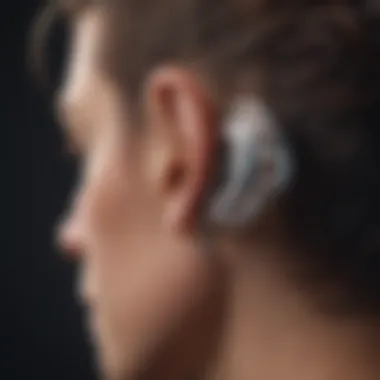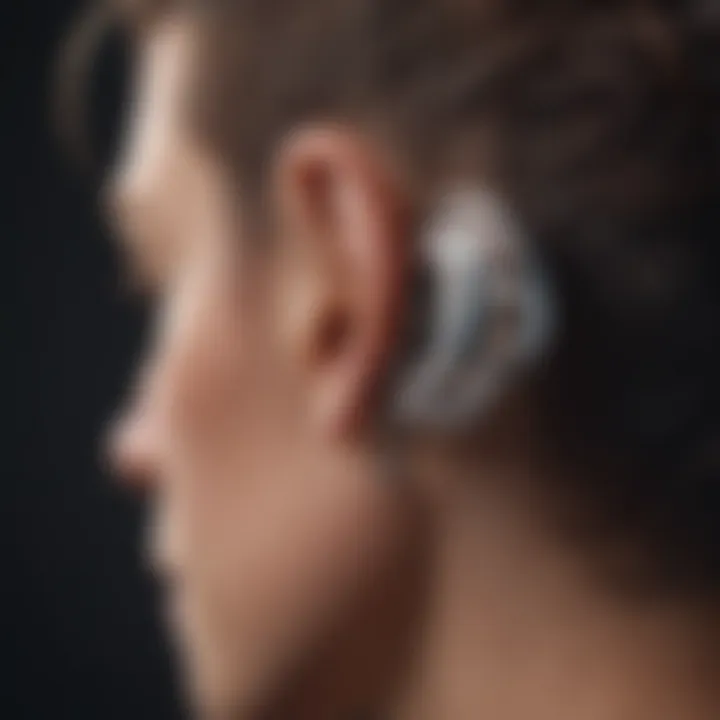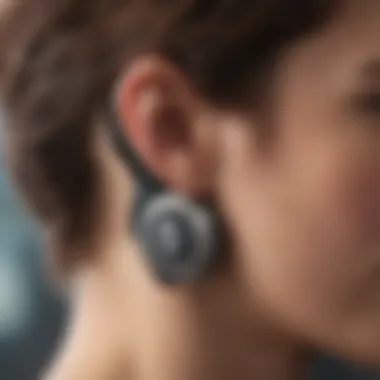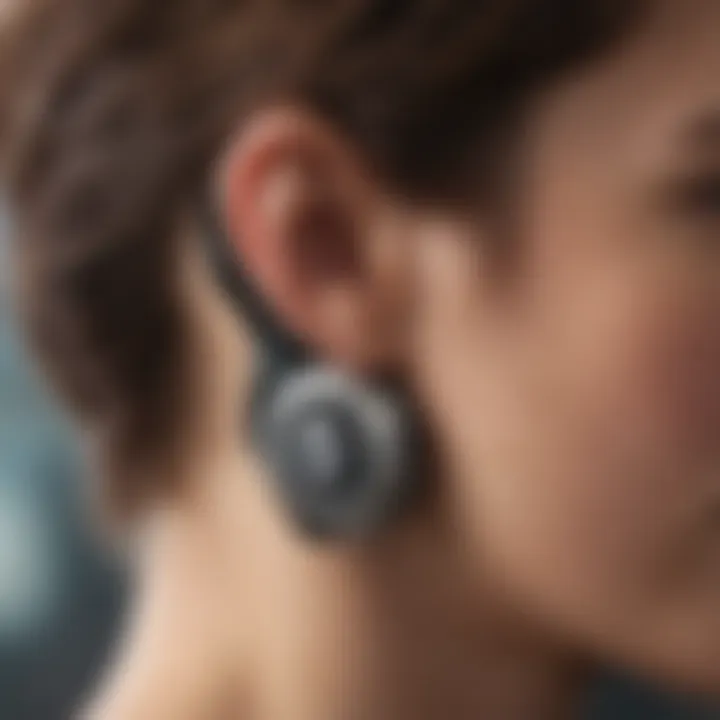Emerging Technologies Transforming Hearing Loss Management


Research Overview
Hearing loss is a complex and prevalent condition affecting millions worldwide. Recent advancements in technology have opened new avenues for managing this condition. This section discusses current methodologies in researching hearing loss technologies and the significance of these developments.
Methodological Approaches
Recent studies employ a mix of qualitative and quantitative methodologies to evaluate emerging technologies. Surveys and interviews often form the bedrock, collecting data from patients, audiologists, and researchers. Additionally, clinical trials are essential in determining the efficacy of new auditory devices and interventions. The integration of user feedback in real time helps enhance the design and functionality of hearing devices.
Significance and Implications
The implications of research into auditory technologies are far-reaching. Not only do these advancements improve individual outcomes, but they also pave the way for enhanced public health strategies. Innovative technologies could lead to earlier detection and more personalized solutions for hearing loss, thereby increasing life quality.
Including a diverse range of perspectives enhances the understanding of user needs and preferences, ultimately shaping better products.
"Customers are often the best sources of insights into product improvement, making their feedback crucial for innovation."
Current Trends in Science
As we investigate the realm of auditory assistance, it is evident that current scientific trends focus on innovation and interdisciplinary collaboration.
Innovative Techniques and Tools
Among the various technologies being introduced, artificial intelligence (AI) is a game-changer. AI algorithms analyze user preferences and auditory environments, allowing for adaptive sound enhancement. Similarly, emerging wearable devices offer features like real-time language translation, which is revolutionary in breaking down communication barriers.
Mobile applications designed for auditory training provide users with flexibility and tailored exercises, optimizing their hearing capabilities.
Interdisciplinary Connections
Innovations in hearing loss management require input from various fields such as engineering, computer science, and linguistics. This interdisciplinary approach fosters a more comprehensive understanding of auditory challenges and solutions. For instance, collaboration between software developers and audiologists leads to more effective and user-friendly applications.
Researchers also increasingly examine the psychological aspects of hearing loss, aiming to create technologies that address emotional and social factors impacting users.
Preamble to Hearing Loss
Hearing loss, a condition affecting millions worldwide, is a significant public health issue. It impacts communication, social interaction, and overall quality of life. With technological advancements, it is vital to understand the nuances of hearing loss. This section will cover essential aspects of hearing loss, setting the stage for a broader discussion on emerging technologies. We will look at the various types of hearing loss, their unique characteristics, and their prevalence.
Overview of Hearing Loss
Hearing loss occurs when there is a problem in one or more parts of the ear. This can include the outer ear, the middle ear, or the inner ear, and can lead to a partial or complete inability to hear. Early diagnosis and management are crucial to preventing further deterioration. Different strategies exist to mitigate the effects, and understanding these can lead to better outcomes.
Types of Hearing Loss
Hearing loss can be classified into three main types, each with its own implications and treatment options:
Conductive Hearing Loss
Conductive hearing loss happens when sound cannot efficiently pass through the outer ear canal to the eardrum. Common causes include ear infections, fluid in the middle ear, or earwax buildup. This type of hearing loss is often temporary and can be treated with medical intervention, such as surgery or hearing aids. Its key characteristic is that the sound may be muffled but not entirely absent, making it easier to address through various means. The benefit of highlighting conductive hearing loss is its often reversible nature, which can offer hope to those affected.
Sensorineural Hearing Loss
Sensorineural hearing loss results from damage to the inner ear or the auditory nerve. It is typically permanent and can range from mild to profound. This can stem from aging, noise exposure, or genetic factors. The primary feature of sensorineural hearing loss is that it can affect the clarity of sounds, making conversations difficult. Despite its challenges, it is discussed frequently because of the importance of understanding adaptive technologies and audiological strategies to help those with this condition.
Mixed Hearing Loss
Mixed hearing loss indicates a combination of conductive and sensorineural components. Individuals may experience symptoms from both types, leading to varied hearing challenges. This type is complex and requires a tailored approach to treatment. It is crucial to consider this group as they often represent more challenging cases in audiology, illustrating the need for more integrated solutions.
Statistics and Prevalence
Hearing loss is more common than one might think. According to the World Health Organization, around 466 million people worldwide experience disabling hearing loss. This number is expected to rise with the aging population and increased exposure to loud noises. Understanding these statistics is vital for raising awareness and mobilizing resources for research and development in this field. It underscores the urgency for innovative solutions to provide support for the growing number of individuals who will experience hearing loss.
Current Solutions for Hearing Impairment
Hearing impairment affects millions globally, and addressing it is essential for improving the quality of life. This section focuses on existing solutions that cater to various levels and types of hearing loss. From hearing aids to cochlear implants, and assistive listening devices, understanding these options is vital for any discussion on hearing technologies. The importance lies not only in their functionality but also in the choices they offer to individuals seeking auditory assistance. Each solution has distinct features and advantages, making it crucial for users to evaluate what best fits their needs.
Hearing Aids
Hearing aids are the most common devices used to assist those with hearing loss. They amplify sound, allowing users to communicate better and engage with their surroundings. These devices come in several types, each catering to specific user needs.
Analog Hearing Aids
Analog hearing aids have been on the market for many years. They amplify sound waves and convert them to electrical signals.
Key Characteristic: Their straightforward design and maintenance make them appealing.
Analog hearing aids are often considered beneficial for individuals with mild to moderate hearing loss. They can be adjusted to specific frequencies, allowing for user customization based on hearing preferences. However, they tend to lack the advanced features offered by newer technologies like feedback cancellation.
Digital Hearing Aids


Digital hearing aids utilize advanced technology to convert sound waves into digital signals, which can be manipulated more effectively.
Key Characteristic: These devices offer superior sound quality compared to their analog counterparts.
They excel at reducing background noise and providing clearer sound to the user. Digital hearing aids also offer programming options to fit various listening environments, making them a popular choice. However, the initial cost tends to be higher compared to analog aids.
Smart Hearing Aids
Smart hearing aids represent the latest advancement in hearing technology. They not only amplify sound but also connect to smartphones and other devices.
Key Characteristic: Their connectivity enhances user experience through app integration and remote adjustments.
These aids offer features like automatic adjustment to ambient noise levels and personalized sound settings. One downside is the complexity of use and potentially higher price point, which may limit accessibility for some users.
Cochlear Implants
Cochlear implants serve as an alternative for individuals with severe to profound hearing loss. Unlike traditional hearing aids, these devices bypass damaged portions of the ear and directly stimulate the auditory nerve.
How They Work
Cochlear implants consist of an external microphone and an internal receiver.
Key Characteristic: They function by converting sound into electrical signals that the brain interprets as sound.
This process is highly effective for those who cannot benefit from hearing aids. While cochlear implants can significantly improve communication abilities, the procedure involves surgery and a lengthy rehabilitation process.
Candidates for Cochlear Implants
Not everyone is a suitable candidate for cochlear implantation. Typically, candidates include those with severe hearing loss who do not benefit from hearing aids.
Key Characteristic: Assessments by health professionals determine candidacy based on several factors.
This includes the degree of hearing loss, age, and overall health. The requirement for comprehensive evaluation can create barriers for some individuals, delaying access.
Post-Implantation Care
Post-implantation care is essential for the success of cochlear implants. Regular check-ups and auditory rehabilitation are necessary to adjust settings and improve listening skills.
Key Characteristic: Continuous support is required for optimal adaptation.
Following surgery, some individuals face challenges in adjusting to new sound perceptions. This can be overwhelming and requires time and patience.
Assistive Listening Devices
Assistive listening devices complement traditional hearing aids and cochlear implants. They can enhance sound in specific situations, making them versatile tools for managing hearing loss in various environments.
FM Systems
FM systems transmit sound directly to the hearing aid or cochlear implant, improving clarity especially in noisy settings.
Key Characteristic: They are highly effective in classrooms and public spaces.
The direct audio input minimizes background noise, allowing for clearer conversations. On the downside, they may require additional equipment, which can be cumbersome for some users.
Induction Loop Systems
Induction loop systems use electromagnetic fields to transmit sound.
Key Characteristic: They allow users to connect directly with the sound source.
These systems are often found in public venues like theaters. However, accessibility may be limited depending on venue installations.
Personal Amplifiers
Personal amplifiers are portable devices that amplify sound for individual users in specific situations.
Key Characteristic: Their ease of use and portability make them attractive for personal use.
These devices can be ideal for one-on-one conversations or small groups. Yet, improper usage may lead to discomfort or sound distortion if not adjusted properly.
Innovative Technologies on the Horizon
The field of hearing loss management is undergoing significant transformation. Innovative technologies are paving the way for new methods of diagnosis, treatment, and ongoing support for individuals with hearing impairments. This section explores various technological advances that hold great promise for the future.
Key innovative elements in this landscape include implantable hearing solutions, artificial intelligence applications, telehealth, and wearable technology. The emergence of these technologies can enhance accessibility and tailor solutions for different needs. While they offer substantial potential, they also present considerations concerning ethical implications, financial investments, and the adaptation of existing healthcare frameworks.
Implantable Hearing Solutions
Implantable hearing solutions represent a significant shift from traditional hearing aids.


Bone-Anchored Hearing Aids
Bone-Anchored Hearing Aids (BAHA) offer an effective route for individuals with conductive hearing loss or single-sided deafness. This device consists of a small titanium implant placed in the skull behind the ear, which transmits sound vibrations directly to the inner ear through bone conduction. This unique capability is particularly beneficial as it bypasses any issues in the outer or middle ear.
Key Feature: The primary characteristic of BAHA is its use of bone conduction, offering a more natural hearing experience for certain patients. It is often favored for individuals who do not benefit from traditional hearing aids due to anatomical challenges.
Advantages: BAHA devices can improve sound clarity and reduce feedback issues commonly associated with conventional systems. However, they require surgical intervention and can carry risks inherent to surgery.
Middle Ear Implants
Middle Ear Implants (MEIs) serve as another alternative method for treating hearing loss. Unlike traditional hearing aids, which amplify sound, MEIs use a surgically implanted device that directly stimulates the middle ear structures to improve sound transmission. This can be a fitting option for those who have otosclerosis or other middle ear problems.
Key Feature: The uniqueness of MEIs lies in their ability to interact mechanically with existing ear structures, making them useful in specific medical situations.
Advantages: They can provide improved sound quality without the occlusion effect that often accompanies hearing aids. Yet, like BAHA, they involve surgical procedures and could lead to complications associated with implantation.
AI and Machine Learning Applications
Artificial Intelligence and machine learning are also paving the way for personalized hearing solutions.
Personalized Sound Processing
Personalized Sound Processing (PSP) leverages AI to adjust sound settings based on individual listening environments and preferences. This technology enhances the user's experience by ensuring optimal sound clarity and comfort in various situations.
Key Feature: The primary characteristic of PSP is its real-time adaptability, which modifies acoustic parameters according to the geography and ambiance of the listening environment.
Advantages: Such systems can minimize user intervention and provide a more individualistic auditory experience. However, reliance on algorithms may risk overlooking nuance in complex acoustic situations without human oversight.
Predictive Analytics for Hearing Loss
Predictive Analytics allows healthcare providers to interpret trends in a patient's hearing ability over time. By analyzing data, practitioners can foresee changes in hearing capacity and adjust treatment plans proactively.
Key Feature: The major strength of predictive analytics is its data-driven approach that enhances early intervention strategies.
Advantages: This technology can lead to timely adjustments in treatment, positively affecting outcomes. There is an ongoing need for data accuracy and the ethical use of personal health information, which presents some challenges.
Telehealth in Audiology
Telehealth has become an essential component of modern healthcare, including audiology.
Remote Hearing Assessments
Remote Hearing Assessments allow patients to undergo hearing tests using digital tools without visiting a clinic. These assessments can be beneficial, especially for individuals with mobility issues or those living in remote areas.
Key Feature: The main characteristic is its convenience, offering clinicians the ability to collect vital patient data remotely.
Advantages: As assessments can occur in familiar environments, this reduces stress and can yield more accurate results. However, it relies heavily on access to technology and may not be suitable for all individuals.
Teletherapy for Auditory Rehabilitation
Teletherapy connects patients with audiologists through virtual platforms for auditory rehabilitation. This approach makes therapy sessions more accessible and flexible, enabling patients to participate from their homes.
Key Feature: Accessibility is a central tenet of teletherapy, which can foster greater engagement from patients.
Advantages: The flexibility can significantly enhance patient adherence to therapy. However, the quality of therapy can vary based on the comfort levels with technology and internet connectivity.
Wearable Technology for Hearing Enhancement
Wearable technologies are bridging the gap between health monitoring and hearing support.
Smartphone Compatibility
Smartphone compatibility extends the functionality of hearing aids by incorporating mobile apps for control and personalization. Users can adjust settings, stream audio, and even receive updates through their phones.
Key Feature: The integration with smartphones delivers ease of use and enhanced control over auditory experiences.
Advantages: This technology enhances user independence but requires users to be technologically adept and may lead to confusion for some.
Fitness Trackers with Hearing Features
Fitness trackers equipped with hearing features provide an innovative approach to merging health tracking and auditory management. These devices may offer alerts about the user's surroundings, helping to keep them informed of vital audio information.
Key Feature: The key characteristic of fitness trackers is their multitasking ability to cater to health and hearing simultaneously.
Advantages: Such technologies can keep users aware of their environments, supporting their overall safety. However, performance can vary, and not all features may be widely beneficial for all users.
The Role of Biotechnology in Hearing Loss Treatments
Biotechnology plays an increasingly significant role in the treatment and management of hearing loss. As scientific understanding grows, biotechnological innovations offer potential solutions that were once considered unattainable. These developments have the ability to address the underlying causes of hearing impairments rather than just their symptoms. Addressing hearing loss through these advanced methods can lead to more effective treatments and improved patient outcomes.


Gene Therapy for Auditory Restoration
Gene therapy aims to correct defective genes responsible for hearing loss. This approach holds promise, particularly for hereditary forms of hearing impairment. By delivering functional genes to the inner ear, researchers aim to halt or even reverse the progression of auditory degeneration. Studies have shown encouraging results in animal models, suggesting that gene therapy may soon provide a viable option for humans.
A key aspect of gene therapy is its potential for targeted treatment. Unlike traditional therapies that may affect the entire body, gene therapy can focus on specific cells or tissues, thereby minimizing side effects. However, challenges remain in delivery mechanisms and ensuring long-term expression of the therapeutic genes.
Stem Cell Research in Hearing Loss
Stem cell research presents another frontier in the treatment of hearing loss. Stem cells have the capability to differentiate into various cell types, including those found in the auditory system. This characteristic makes them a potential source for restoring damaged or lost hearing cells, such as hair cells in the cochlea.
Research is still in early stages but shows great potential in auditory applications. For instance, stem cells could be transplanted into the inner ear to replace damaged cells. Moreover, stem cells might be utilized to drive regeneration in individuals with age-related hearing loss. However, ethical considerations and the need for further regulatory guidelines pose significant challenges that must be navigated before clinical applications can be widely offered.
Pharmaceutical Advances
Pharmaceutical advances in hearing loss treatments involve the exploration of new drugs and repurposing existing ones. This area of research is critical due to its potential to improve the lives of those with hearing impairments significantly.
Drug Repurposing for Auditory Therapies
Drug repurposing involves taking existing medications developed for other conditions and adapting them for hearing loss treatments. This strategy is particularly attractive because it can significantly reduce development time and costs. Several studies are investigating how drugs initially approved for conditions like cancer or inflammation may also protect against or mitigate hearing loss.
A key characteristic of drug repurposing is its efficiency. Existing data on safety and efficacy can accelerate the approval process for hearing loss interventions. Despite these advantages, there are limitations. The drug's primary effects may not align perfectly with the specific needs for treating auditory conditions.
New Drug Developments
New drug developments are also crucial for addressing hearing loss. Innovative compounds are being designed to target specific mechanisms involved in hearing impairment. These drugs may work by enhancing cochlear synaptic function or by promoting inner ear healing.
What sets these new drugs apart is their focus on molecular pathways that contribute to hearing loss. Potential benefits include more effective treatments that address specific types of hearing loss. However, the challenge lies in ensuring that these new therapies are both effective and safe for patients.
In summary, the role of biotechnology is reshaping how hearing loss is managed. Techniques like gene therapy, stem cell research, and innovative pharmaceutical developments carry the potential to fundamentally alter the treatment landscape.
"By utilizing biotechnological advancements, the future of hearing loss management could evolve from reactive treatment to proactive restoration."
Continued research and clinical trials will be essential in realizing these potentials and overcoming the barriers that currently exist.
Ethical Considerations in Hearing Loss Technologies
The integration of emerging technologies in the realm of hearing loss management brings with it numerous ethical considerations that cannot be overlooked. These concerns span various spheres including accessibility, privacy, and the necessity of informed consent. Such discussions are vital as they frame the responsible use of technology in enhancing individual lives. Moreover, as societal reliance on auditory assistive devices grows, the ethical implications become increasingly significant in guiding the development and implementation of these technologies.
Accessibility and Equity
Accessibility is fundamental in the context of hearing loss technologies. Many individuals with hearing impairments face barriers not only in the availability of devices but also in the financial aspects associated with them. The high costs of advanced hearing aids, cochlear implants, and assistive listening devices can exclude lower-income families. This inequity can create a significant disparity in health outcomes among different socioeconomic groups.
Policies aimed at making hearing technologies more accessible are crucial. For instance, healthcare systems should consider subsidy programs, allowing wider access to cutting-edge solutions. Non-profit organizations and community initiatives can also play a role in bridging this gap. It is essential that all individuals, regardless of their financial status, be able to benefit from advancements in hearing technology.
Privacy Concerns with Hearing Devices
As technology becomes more integrated into personal health, privacy concerns inevitably arise. Devices such as smart hearing aids often collect a wealth of data about users, including personal habits and preferences. This data, if not managed properly, could be misused or inadequately protected against breaches.
Manufacturers must institute stringent privacy protocols to ensure data security. Users should be informed about what data is collected, how it is used, and their rights regarding this information. Transparency in data handling practices is essential to maintain trust between users and manufacturers. The evolving landscape of technology must prioritize ethical standards in protecting personal information.
Informed Consent for New Treatments
Informed consent is another cornerstone of ethical considerations in audio technologies. As new treatments and devices emerge, it becomes increasingly important that users understand what they are agreeing to. This entails a clear explanation of the benefits, risks, and limitations of new auditory technologies.
Healthcare providers should provide adequate information regarding how the devices work, possible side effects, and what the expected outcomes are. Patients must feel empowered to make informed decisions about their treatment options. The obligation rests not only on medical professionals but also on technology developers to ensure that users receive comprehensive education about the innovations they are adopting.
"Ethical considerations are not just an afterthought; they must be integrated into the very fabric of technology development and deployment in hearing loss management."
Epilogues and Future Directions
The exploration of emerging technologies for hearing loss reveals a complex landscape that is continually evolving. The conclusions drawn from the analysis not only highlight the current state of interventions for hearing loss but also project future possibilities and necessary advancements. This section encapsulates the significance of these conclusions, focusing on the benefits they can bring to both individuals and the medical community.
Current Challenges in Technology Adoption
Despite the potential benefits, several challenges hinder the widespread adoption of emerging hearing technologies. These challenges include:
- Cost Issues: High prices can limit access to innovative devices, especially for those with average or low incomes.
- Awareness and Education: Many potential users remain unaware of recent advancements or do not understand how these technologies can benefit them.
- Standards and Regulations: The lack of standardized guidelines for new technologies makes it difficult for practitioners to recommend the best solutions.
- Limited Infrastructure: In some regions, the healthcare infrastructure may not support the implementation of emerging technologies, thereby restricting access.
"The integration of advanced technologies must include strategies to overcome these barriers, ensuring that innovations can be accessed by those who need them the most."
The Future Landscape of Hearing Technologies
Looking towards the future, the landscape of hearing technologies is expected to transform significantly. Major trends likely to shape this evolution include:
- Integration of Artificial Intelligence: AI will enhance personalized hearing solutions, allowing devices to adapt in real-time to various environments.
- Increased Connectivity: The rise of the Internet of Things (IoT) can facilitate seamless communication between hearing devices and other smart technology, improving user experience.
- Regenerative Medicine: Ongoing research in gene therapy and stem cell treatment may lead to groundbreaking methods for restoring hearing, potentially reducing reliance on traditional aids.
- User-Centric Designs: Future devices may focus more on user experience, featuring simpler interfaces and improved ergonomics.
Such advancements promise to improve the quality of life for individuals experiencing hearing impairments.
The Importance of Continued Research
Continued research in the field of hearing technology is essential for several reasons:
- Developing Effective Solutions: Innovations, whether through devices, apps, or surgical techniques, need rigorous research to ensure efficacy and safety.
- Addressing Diverse Needs: Research helps to understand the varying needs of individuals with hearing impairments, leading to tailored solutions.
- Evaluating Long-Term Impact: Ongoing studies can assess long-term effects of new technologies on user adaptation and satisfaction.
- Funding and Support: Demonstrating the impact of research can motivate stakeholders to invest more resources into emerging technologies.
The future of hearing loss management lies in a commitment to continue development and investigation of these innovative approaches. Ensuring progress requires collective efforts from researchers, practitioners, and technology developers.



